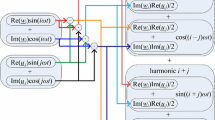Abstract
This paper presents a methodology that combines the dynamic harmonic domain analysis and discrete companion circuit modeling resulting in a powerful analytic technique, called companion harmonic circuit modeling. This new approach provides a complete method for dynamic harmonic analysis of electric circuits, preserving the advantages of discrete companion circuit models and harmonic analysis, resulting in an accurate steady state initialization and transient analysis method. An illustrative electric system will be used to show power of the proposed technique.
Similar content being viewed by others
Abbreviations
- DHD:
-
Dynamic harmonic domain
- SSI:
-
Steady state initialization
- CHCM:
-
Companion harmonic circuit models
- ETA:
-
Electromagnetic transient analysis
- EMTP:
-
Electromagnetic transients program
- CDA:
-
Critical damping adjustment
References
Chua LO, Lin PM (1975) Computer-aided analysis of electronic circuits, algorithms and computational techniques. Prentice Hall, Upper Saddle River
Dommel HW (1978) Electro-magnetic transient program (EMTP) theory book
Lina KL, Noda T (2010) A time-domain harmonic power-flow algorithm for obtaining nonsinusoidal steady-state solution. IEEE Trans Power Deliv 25(3): 1888–1898
Jalili-Marandi V, Dinavahi V, Strunz K, Martinez JA, Ramirez A (2009) Interfacing techniques for transient stability and electromagnetic transient programs. IEEE Trans Power Deliv 24(4): 2385–2395
Dommel HW, Yan A, Wei S (1986) Harmonics from transformer saturation. IEEE Trans Power Syst PWRD-1(2): 209–215
Perkins BK, Martí JR, Dommel HW (1995) Nonlinear elements in the EMTP: steady-state initialization. IEEE Trans Power Deliv 10(2): 593–601
Lombard X, Mahseredjian J, Lefebvre S, Kieny C (1995) Implementation of a new harmonic initialization method in the EMTP. IEEE Trans Power Deliv 10(3): 1343–1352
Murere G, Lefevre S, Do XD (1995) A generalized harmonic balance method for EMTP initialization. IEEE Trans Power Deliv 10(3): 1353–1359
Noda T, Nagaoka N, Ametani A (1997) Further improvement to a phase-domain ARMA line model in terms of convolution, steady-state initialization, and stability. IEEE Trans Power Deliv 12(3): 1327–1334
Lima LTG, Semlyen A, Iravani MR (2003) Harmonic domain periodic steady state modeling of power electronics apparatus: SVC and TCSC. IEEE Trans Power Deliv 18(3): 960–967
Noda T, Semlyen A, Iravani R (2003) Harmonic domain dynamic transfer function of a nonlinear time-periodic network. IEEE Trans Power Deliv 18(4): 1433–1441
Noda T, Semlyen A, Iravani R (2004) Entirely harmonic domain calculation of multiphase nonsinusoidal steady state. IEEE Trans Power Deliv 19(3): 1368–1377
Ramirez A (2009) Frequency-domain computation of steady and dynamic states including nonlinear elements. IEEE Trans Power Deliv 24(3): 1609–1615
Acha E, Madrigal M (2001) Power systems analysis: computer modelling and analysis. Wiley, New York
Rico JJ, Madrigal M, Acha E (2003) Dynamic harmonic evolution using the extended harmonic domain. IEEE Trans Power Deliv 18(2): 589–594
Madrigal M, Rico JJ (2004) Operational matrices for the analysis of periodic dynamic systems. IEEE Trans Power Syst 19: 1693–1695
Madrigal M, Rico JJ (2006) Analytical method for calculating steady-state initial value conditions of dynamic periodic networks with nonlinear components. Taylor & Francis Trans Electric Power Compon Syst 34: 1331–1347
Krein PT, Bentsman J, Bass RM, Lesieutre BL (1990) On the use of averaging for the analysis of power electronic systems. IEEE Trans Power Electron 5: 182–190
Sanders SR, Noworolski JM, Lui XZ, Verghese GC (1991) Generalized averaging method for power conversion circuits. IEEE Trans Power Electron 6: 251–259
Caliskan VA, Verghese GC, Stankovic AM (1999) Multifrequency averaging of DC/DC converters. IEEE Trans Power Electron 14: 124–133
Banerjee S, Verghese GC (2001) Nonlinear phenomena in power electronics. IEEE Press, New York
Stankovic AM, Aydin T (2000) Analysis of asymmetrical faults in power systems using dynamic phasors. IEEE Trans Power Syst 15: 1062–1086
Stankovic AM, Mattavelli P, Caliskan V, Verghese GC (2000) Modeling and analysis of FACTS devices with dynamic phasors. In: Proc IEEE Power Eng Soc, Winter Meeting, vol 2, Singapore, 23–27 Jan 2000, pp 1440–1446
Martí JR, Lin J (1989) Suppression of numerical oscillations in the EMTP. IEEE Trans Power Deliv 18(2): 739–747
Author information
Authors and Affiliations
Corresponding author
Rights and permissions
About this article
Cite this article
Garcia, H., Madrigal, M. Companion harmonic circuit models for transient studies. Electr Eng 95, 43–51 (2013). https://doi.org/10.1007/s00202-012-0239-5
Received:
Accepted:
Published:
Issue Date:
DOI: https://doi.org/10.1007/s00202-012-0239-5




